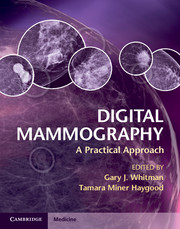Book contents
- Frontmatter
- Contents
- List of contributors
- Preface
- Acknowledgments
- Chapter 1 Detectors for digital mammography
- Chapter 2 Image acquisition
- Chapter 3 Preparing digital mammography images for interpretation
- Chapter 4 Image display and visualization in digital mammography
- Chapter 5 PACS, storage, and archiving
- Chapter 6 Interpretation of digital screening mammography
- Chapter 7 Efficacy of digital screening mammography
- Chapter 8 Artifacts in digital mammography
- Chapter 9 Mobile digital mammography
- Chapter 10 Procedures with digital mammography
- Chapter 11 Digital breast tomosynthesis
- Chapter 12 Breast computed tomography
- Chapter 13 Cases
- Chapter 14 Comparison of commercially available systems
- Index
- References
Chapter 3 - Preparing digital mammography images for interpretation
Published online by Cambridge University Press: 05 December 2012
- Frontmatter
- Contents
- List of contributors
- Preface
- Acknowledgments
- Chapter 1 Detectors for digital mammography
- Chapter 2 Image acquisition
- Chapter 3 Preparing digital mammography images for interpretation
- Chapter 4 Image display and visualization in digital mammography
- Chapter 5 PACS, storage, and archiving
- Chapter 6 Interpretation of digital screening mammography
- Chapter 7 Efficacy of digital screening mammography
- Chapter 8 Artifacts in digital mammography
- Chapter 9 Mobile digital mammography
- Chapter 10 Procedures with digital mammography
- Chapter 11 Digital breast tomosynthesis
- Chapter 12 Breast computed tomography
- Chapter 13 Cases
- Chapter 14 Comparison of commercially available systems
- Index
- References
Summary
Introduction
The basic advantages and disadvantages of digital mammography and the relevant technology are discussed in other chapters of this book. Results of the Digital Mammographic Imaging Screening Trial (DMIST), released in September 2005, show that digital mammography may be more accurate at detecting breast cancer in some women than standard film-screen mammography [1,2]. In that study, digital and standard film-screen mammography had similar accuracy for many women. However, digital mammography was significantly better at screening women younger than 50 years, regardless of their breast tissue density, and women of any age with very dense or extremely dense breasts. In this context, the significant advantages of digital mammography for image interpretation include the following:
physician manipulation of breast images for more accurate detection of breast cancer
ability to correct underexposure or overexposure of images without having to repeat the mammogram
transmittal of images over a network for remote consultation with other physicians
The primary focus of this chapter is post-processing of raw digital mammography images for interpretation, including digital mammography display, and comparison with prior mammography studies, including analog (film-screen or digitized) mammography studies.
- Type
- Chapter
- Information
- Digital MammographyA Practical Approach, pp. 22 - 26Publisher: Cambridge University PressPrint publication year: 2012



